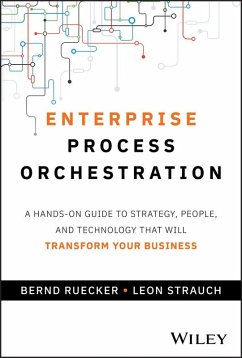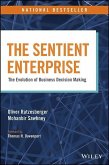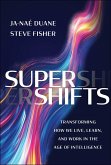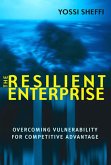Bernd Ruecker, Leon Strauch
Enterprise Process Orchestration
A Hands-On Guide to Strategy, People, and Technology That Will Transform Your Business
Bernd Ruecker, Leon Strauch
Enterprise Process Orchestration
A Hands-On Guide to Strategy, People, and Technology That Will Transform Your Business
- Gebundenes Buch
- Merkliste
- Auf die Merkliste
- Bewerten Bewerten
- Teilen
- Produkt teilen
- Produkterinnerung
- Produkterinnerung
Praise for ENTERPRISE PROCESS ORCHESTRATION "At Deutsche Telekom, we've built one of Europe's largest process automation ecosystems, gaining valuable insights along the way. Bernd and Leon have captured key lessons from across the field in a structured, accessible way, making this book a must-read for anyone looking to advance process automation!" -MARCO EINACKER, VP of Automation & DevOps Excellence, Deutsche Telekom Service GmbH "In the ever-changing world of process automation, this book delivers powerful guidance on establishing a robust, fast-to-market process orchestration program to…mehr
Andere Kunden interessierten sich auch für
![The Sentient Enterprise The Sentient Enterprise]() Oliver Ratzesberger (Teradata Corporation)The Sentient Enterprise29,99 €
Oliver Ratzesberger (Teradata Corporation)The Sentient Enterprise29,99 €![Supershifts Supershifts]() Ja-Nae DuaneSupershifts25,99 €
Ja-Nae DuaneSupershifts25,99 €![Acoustic and MIDI Orchestration for the Contemporary Composer Acoustic and MIDI Orchestration for the Contemporary Composer]() Andrea PejroloAcoustic and MIDI Orchestration for the Contemporary Composer59,99 €
Andrea PejroloAcoustic and MIDI Orchestration for the Contemporary Composer59,99 €![The Resilient Enterprise The Resilient Enterprise]() Yossi Sheffi (Massachusetts Institute of Technology)The Resilient Enterprise21,99 €
Yossi Sheffi (Massachusetts Institute of Technology)The Resilient Enterprise21,99 €![Rural Tourism and Enterprise Rural Tourism and Enterprise]() Ade OriadeRural Tourism and Enterprise62,99 €
Ade OriadeRural Tourism and Enterprise62,99 €![The Routledge Companion to Musical Theatre The Routledge Companion to Musical Theatre]() The Routledge Companion to Musical Theatre48,99 €
The Routledge Companion to Musical Theatre48,99 €![The Technique of Orchestration The Technique of Orchestration]() Kent KennanThe Technique of Orchestration176,99 €
Kent KennanThe Technique of Orchestration176,99 €-
-
-
Praise for ENTERPRISE PROCESS ORCHESTRATION "At Deutsche Telekom, we've built one of Europe's largest process automation ecosystems, gaining valuable insights along the way. Bernd and Leon have captured key lessons from across the field in a structured, accessible way, making this book a must-read for anyone looking to advance process automation!" -MARCO EINACKER, VP of Automation & DevOps Excellence, Deutsche Telekom Service GmbH "In the ever-changing world of process automation, this book delivers powerful guidance on establishing a robust, fast-to-market process orchestration program to tackle even the most complex challenges!" -JAMES HOLT, BPM Platform Manager, NatWest Bank plc "I've spent the better part of 21 years helping corporations adopt process orchestration at scale - and this book represents the best guidebook I've ever read on the subject. Bernd and Leon make this material relatable, teachable, and actionable. I wish I could have given this book to every team member and every client I ever worked with." -SCOTT FRANCIS, Founder and CEO of BP3 "Enterprise Process Orchestration captures the methodology and proven practices that have driven the many successful outcomes of business process automation projects using one of the fastest growing enterprise orchestration and decision tools in the market. This book is an invaluable resource for anyone looking to master real-world process orchestration, whether they're just starting out or refining their approach." -PAUL VINCENT, Independent Analyst, former Research Director at Gartner "This book provides a strategic yet hands-on approach to enterprise process orchestration, bridging the gap between vision and execution. In today's fast-changing business landscape, organizations must integrate automation, AI, and human work seamlessly - this book offers the roadmap to do just that. A must-read for anyone driving large-scale digital transformation." -LARS TANDRUP, Principal and Process Solutions & Automation Lead at EY Advisory
Produktdetails
- Produktdetails
- Verlag: John Wiley & Sons Inc
- Seitenzahl: 304
- Erscheinungstermin: 21. April 2025
- Englisch
- Abmessung: 231mm x 153mm x 26mm
- Gewicht: 588g
- ISBN-13: 9781394309672
- ISBN-10: 1394309678
- Artikelnr.: 72015551
- Herstellerkennzeichnung
- Libri GmbH
- Europaallee 1
- 36244 Bad Hersfeld
- gpsr@libri.de
- Verlag: John Wiley & Sons Inc
- Seitenzahl: 304
- Erscheinungstermin: 21. April 2025
- Englisch
- Abmessung: 231mm x 153mm x 26mm
- Gewicht: 588g
- ISBN-13: 9781394309672
- ISBN-10: 1394309678
- Artikelnr.: 72015551
- Herstellerkennzeichnung
- Libri GmbH
- Europaallee 1
- 36244 Bad Hersfeld
- gpsr@libri.de
BERND RUECKER is Co-founder of Camunda, a leading process orchestration platform. An expert in process automation, he has extensive experience in scalable and agile environments of industry leaders like Atlassian, ING, and Vodafone. LEON STRAUCH is a Process Orchestration Strategist at Camunda, helping organizations navigate process automation and digital transformation. With a background in B2B management, communication studies, and enterprise software, he develops strategies to scale process orchestration effectively.
Foreword xiii
Preface xv
Why Automation? xviii
Avoid the Value Trap of Local Automations xx
Focus on Processes xxi
The Methodology Behind This Book xxii
How to Read This Book xxvi
Who Should Read This Book xxvii
About the Authors xxix
Introduction 1
Process Orchestration in the Context of Automation 1
Process Automation = Process Orchestration + Task Automation 2
Challenges Process Orchestration Solves 4
Taming Process Complexity 5
Process Orchestration Engines and Executable Process Models 6
The Benefits of Process Orchestration 7
Better Customer Experience 8
Operational Efficiency 10
Risk Mitigation and Compliance 11
Faster Time to Value and Greater Business Agility 12
Enabling Artificial Intelligence 14
Avoiding Technical Debt and Accidental Complexity 15
Understanding Process Types That Can Be Orchestrated 16
Tailor-made Digital Processes 16
Diversity of Business Processes 18
A Useful Categorization of Use Cases 19
Tailoring Your Process Automation Approach 20
Avoiding the Danger Zone Around Vendor Rationalization and Tool
Harmonization 22
Typical Business Processes to Be Orchestrated 23
Financial Services 23
Insurance 25
Telecommunications 26
Public Sector 26
Retail 27
Other Industries 28
Technical Use Cases of Process Orchestration 28
Takeaways 29
Chapter 1: Vision 31
Strategic Alignment: Bridging Vision, Strategy, and Stakeholders 32
Scoping Your Transformation Journey 33
Defining Your Vision 34
Aligning Your Stakeholders 35
Building a Business Architecture to Realize Digitalization and Automation
Benefits 38
The Business Architecture in a Nutshell 38
Customer Journeys and Value Streams 41
Strategic End-to-End Processes 42
Business Capabilities 44
The Role of Executable Processes 48
Avoid Lengthy Discussions About Process Hierarchies 50
Advantages of This Business Architecture 52
Making Informed Decisions About Where to Invest 53
Strategically Improving Your End-to-End Processes 54
Defining Clear Ownership 55
Composing Processes Out of Business Capabilities 55
Enabling Organizational Redesign 56
Establishing a Process-First Mindset 58
Building Your Transformation Roadmap and Implementing Change 59
Adoption Governance (aka Who Owns the Business Architecture?) 60
Understanding Process Orchestration Work Streams 62
Building and Prioritizing Business Cases 65
Amplifying Organic Bottom-Up Initiatives 69
Getting Started on Your Adoption Journey 72
Following a Wave Pattern on Your Journey 72
Enterprise Adoption Phases 73
Questions to Assess Your Maturity 75
Takeaways 77
Chapter 2: People 79
How Software Is Being Built Today 80
Focused Components That Implement Capabilities 80
Agile and DevOps 81
Product Thinking 82
Process Ownership 83
Team Topologies 84
Diversity of Roles 84
A Healthy Level of Centralization 86
Centralized Teams to Facilitate Process Orchestration 88
The Business Process Optimization Group (POG) 89
The Adoption Acceleration Team (AAT) 90
The Relationship Between the POG and AAT 92
Delivery Models 92
Federated Solution Delivery with the AAT as an Enabler 93
Fully Decentralized Delivery 95
Fully Centralized Delivery 96
Roles 99
AAT Leader 99
Enterprise Architect 100
Rainmaker 101
Business Analyst 102
Solution or IT Architect 102
Software Developer 103
Low-Code Developer 104
Operations Engineer 105
Product Owner 105
Zooming in on the Adoption Acceleration Team 106
The Scope of Your AAT 106
What About Communities of Practice (CoPs)? 107
What Should Your AAT Look Like? 108
The Business Case for the AAT 110
Building Your AAT 113
AAT Tasks 114
Governance 121
AAT Anti-Patterns 123
Real-Life Examples 125
Defining Your Target Operating Model 126
Key Dimensions to Define Your Operating Model 127
Sketching Your Journey 130
Questions to Assess Your Maturity 134
Takeaways 135
Chapter 3: Technology 137
Implementing Your Business Architecture 137
Implementing Business Capabilities 138
Technical Capabilities, Platforms, and Enabling Technologies 140
Business Orchestration and Automation Technology 142
Composable vs. Monolithic Platforms 144
Components Required for Process Orchestration 145
Operationalizing AI for Autonomous Orchestration with Guardrails 157
Providing a Process Orchestration Capability to Your Organization 160
Enterprise vs. Solution Scope 160
Platform Thinking 162
Modern Process Orchestration Platforms Don't Become a Bottleneck 165
Why Does This Work Now if SOA Failed a Decade Ago? 165
Chargeback Models 168
Operating a Process Orchestration Platform 169
Running the Platform 169
Isolation Needs and Multitenancy 170
Staging Environments 172
Sizing and Scaling 173
Resilience and High Availability 173
Selecting the Right Process Orchestration Technology 174
Types of Processes: Standard vs. Tailor-Made 174
Scope: Task Automation and Simple Integrations vs. Processes 176
Process Complexity: Simple vs. Complex 177
Scale: Small vs. Big 179
Project Setup: Ad Hoc vs. Strategic 179
Contrasting Process Orchestration with Adjacent Technologies 180
Robotic Process Automation (RPA) 180
Data Flow Engines and Data Streaming 181
Event-Driven Architecture (EDA) and Event Streaming 182
BPM Suites and Low-Code Application Platforms 182
Microservice Orchestrators 183
Tips on Evaluating Tools 183
Questions to Assess Your Maturity 186
Takeaways 187
Chapter 4: Delivery 189
Solution Creation Approach 189
Discover 190
Model 192
Develop 193
Run 194
Monitor 194
Being Agile Throughout the Solution Creation Lifecycle 195
Setting the Stage for Success: Your Early Projects 195
Derisking Your Start with Process Tracking 197
Typical Delivery Teams and Roles 199
Solution Design 201
Greenfield Solution Architecture for Pro-Code Use Cases 202
The Software Development Lifecycle and Model Roundtrips 203
Simplified Solution Architecture for Low-Code Use Cases 205
Typical Questions Around the Development Lifecycle 206
Accelerating Solution Building 209
Questions to Assess Your Maturity 211
Takeaways 212
Chapter 5: Measurement 215
Why Metrics Matter 216
Value Drivers of Enterprise Process Orchestration 218
Understanding Metrics 221
Measurements, Metrics, Goals, KPIs, and SLAs 221
What Makes a Good KPI? 223
Example Metrics and KPIs 225
Operationalizing Your Metric-Driven Approach 228
Metrics Are Not an Afterthought 228
Mapping Metrics and KPIs to Value Drivers 229
Mapping Value Flow Through Business Architecture Layers 231
Modeling for Measurement 233
Setting Up Continuous Measurements and Communication 235
Can't We Just Delegate This to Our Existing Data Warehouse Folks? 239
Questions to Assess Your Maturity 240
Takeaways 241
Closing Thoughts 243
List of Abbreviations 247
References 249
Index 259
Preface xv
Why Automation? xviii
Avoid the Value Trap of Local Automations xx
Focus on Processes xxi
The Methodology Behind This Book xxii
How to Read This Book xxvi
Who Should Read This Book xxvii
About the Authors xxix
Introduction 1
Process Orchestration in the Context of Automation 1
Process Automation = Process Orchestration + Task Automation 2
Challenges Process Orchestration Solves 4
Taming Process Complexity 5
Process Orchestration Engines and Executable Process Models 6
The Benefits of Process Orchestration 7
Better Customer Experience 8
Operational Efficiency 10
Risk Mitigation and Compliance 11
Faster Time to Value and Greater Business Agility 12
Enabling Artificial Intelligence 14
Avoiding Technical Debt and Accidental Complexity 15
Understanding Process Types That Can Be Orchestrated 16
Tailor-made Digital Processes 16
Diversity of Business Processes 18
A Useful Categorization of Use Cases 19
Tailoring Your Process Automation Approach 20
Avoiding the Danger Zone Around Vendor Rationalization and Tool
Harmonization 22
Typical Business Processes to Be Orchestrated 23
Financial Services 23
Insurance 25
Telecommunications 26
Public Sector 26
Retail 27
Other Industries 28
Technical Use Cases of Process Orchestration 28
Takeaways 29
Chapter 1: Vision 31
Strategic Alignment: Bridging Vision, Strategy, and Stakeholders 32
Scoping Your Transformation Journey 33
Defining Your Vision 34
Aligning Your Stakeholders 35
Building a Business Architecture to Realize Digitalization and Automation
Benefits 38
The Business Architecture in a Nutshell 38
Customer Journeys and Value Streams 41
Strategic End-to-End Processes 42
Business Capabilities 44
The Role of Executable Processes 48
Avoid Lengthy Discussions About Process Hierarchies 50
Advantages of This Business Architecture 52
Making Informed Decisions About Where to Invest 53
Strategically Improving Your End-to-End Processes 54
Defining Clear Ownership 55
Composing Processes Out of Business Capabilities 55
Enabling Organizational Redesign 56
Establishing a Process-First Mindset 58
Building Your Transformation Roadmap and Implementing Change 59
Adoption Governance (aka Who Owns the Business Architecture?) 60
Understanding Process Orchestration Work Streams 62
Building and Prioritizing Business Cases 65
Amplifying Organic Bottom-Up Initiatives 69
Getting Started on Your Adoption Journey 72
Following a Wave Pattern on Your Journey 72
Enterprise Adoption Phases 73
Questions to Assess Your Maturity 75
Takeaways 77
Chapter 2: People 79
How Software Is Being Built Today 80
Focused Components That Implement Capabilities 80
Agile and DevOps 81
Product Thinking 82
Process Ownership 83
Team Topologies 84
Diversity of Roles 84
A Healthy Level of Centralization 86
Centralized Teams to Facilitate Process Orchestration 88
The Business Process Optimization Group (POG) 89
The Adoption Acceleration Team (AAT) 90
The Relationship Between the POG and AAT 92
Delivery Models 92
Federated Solution Delivery with the AAT as an Enabler 93
Fully Decentralized Delivery 95
Fully Centralized Delivery 96
Roles 99
AAT Leader 99
Enterprise Architect 100
Rainmaker 101
Business Analyst 102
Solution or IT Architect 102
Software Developer 103
Low-Code Developer 104
Operations Engineer 105
Product Owner 105
Zooming in on the Adoption Acceleration Team 106
The Scope of Your AAT 106
What About Communities of Practice (CoPs)? 107
What Should Your AAT Look Like? 108
The Business Case for the AAT 110
Building Your AAT 113
AAT Tasks 114
Governance 121
AAT Anti-Patterns 123
Real-Life Examples 125
Defining Your Target Operating Model 126
Key Dimensions to Define Your Operating Model 127
Sketching Your Journey 130
Questions to Assess Your Maturity 134
Takeaways 135
Chapter 3: Technology 137
Implementing Your Business Architecture 137
Implementing Business Capabilities 138
Technical Capabilities, Platforms, and Enabling Technologies 140
Business Orchestration and Automation Technology 142
Composable vs. Monolithic Platforms 144
Components Required for Process Orchestration 145
Operationalizing AI for Autonomous Orchestration with Guardrails 157
Providing a Process Orchestration Capability to Your Organization 160
Enterprise vs. Solution Scope 160
Platform Thinking 162
Modern Process Orchestration Platforms Don't Become a Bottleneck 165
Why Does This Work Now if SOA Failed a Decade Ago? 165
Chargeback Models 168
Operating a Process Orchestration Platform 169
Running the Platform 169
Isolation Needs and Multitenancy 170
Staging Environments 172
Sizing and Scaling 173
Resilience and High Availability 173
Selecting the Right Process Orchestration Technology 174
Types of Processes: Standard vs. Tailor-Made 174
Scope: Task Automation and Simple Integrations vs. Processes 176
Process Complexity: Simple vs. Complex 177
Scale: Small vs. Big 179
Project Setup: Ad Hoc vs. Strategic 179
Contrasting Process Orchestration with Adjacent Technologies 180
Robotic Process Automation (RPA) 180
Data Flow Engines and Data Streaming 181
Event-Driven Architecture (EDA) and Event Streaming 182
BPM Suites and Low-Code Application Platforms 182
Microservice Orchestrators 183
Tips on Evaluating Tools 183
Questions to Assess Your Maturity 186
Takeaways 187
Chapter 4: Delivery 189
Solution Creation Approach 189
Discover 190
Model 192
Develop 193
Run 194
Monitor 194
Being Agile Throughout the Solution Creation Lifecycle 195
Setting the Stage for Success: Your Early Projects 195
Derisking Your Start with Process Tracking 197
Typical Delivery Teams and Roles 199
Solution Design 201
Greenfield Solution Architecture for Pro-Code Use Cases 202
The Software Development Lifecycle and Model Roundtrips 203
Simplified Solution Architecture for Low-Code Use Cases 205
Typical Questions Around the Development Lifecycle 206
Accelerating Solution Building 209
Questions to Assess Your Maturity 211
Takeaways 212
Chapter 5: Measurement 215
Why Metrics Matter 216
Value Drivers of Enterprise Process Orchestration 218
Understanding Metrics 221
Measurements, Metrics, Goals, KPIs, and SLAs 221
What Makes a Good KPI? 223
Example Metrics and KPIs 225
Operationalizing Your Metric-Driven Approach 228
Metrics Are Not an Afterthought 228
Mapping Metrics and KPIs to Value Drivers 229
Mapping Value Flow Through Business Architecture Layers 231
Modeling for Measurement 233
Setting Up Continuous Measurements and Communication 235
Can't We Just Delegate This to Our Existing Data Warehouse Folks? 239
Questions to Assess Your Maturity 240
Takeaways 241
Closing Thoughts 243
List of Abbreviations 247
References 249
Index 259
Foreword xiii
Preface xv
Why Automation? xviii
Avoid the Value Trap of Local Automations xx
Focus on Processes xxi
The Methodology Behind This Book xxii
How to Read This Book xxvi
Who Should Read This Book xxvii
About the Authors xxix
Introduction 1
Process Orchestration in the Context of Automation 1
Process Automation = Process Orchestration + Task Automation 2
Challenges Process Orchestration Solves 4
Taming Process Complexity 5
Process Orchestration Engines and Executable Process Models 6
The Benefits of Process Orchestration 7
Better Customer Experience 8
Operational Efficiency 10
Risk Mitigation and Compliance 11
Faster Time to Value and Greater Business Agility 12
Enabling Artificial Intelligence 14
Avoiding Technical Debt and Accidental Complexity 15
Understanding Process Types That Can Be Orchestrated 16
Tailor-made Digital Processes 16
Diversity of Business Processes 18
A Useful Categorization of Use Cases 19
Tailoring Your Process Automation Approach 20
Avoiding the Danger Zone Around Vendor Rationalization and Tool
Harmonization 22
Typical Business Processes to Be Orchestrated 23
Financial Services 23
Insurance 25
Telecommunications 26
Public Sector 26
Retail 27
Other Industries 28
Technical Use Cases of Process Orchestration 28
Takeaways 29
Chapter 1: Vision 31
Strategic Alignment: Bridging Vision, Strategy, and Stakeholders 32
Scoping Your Transformation Journey 33
Defining Your Vision 34
Aligning Your Stakeholders 35
Building a Business Architecture to Realize Digitalization and Automation
Benefits 38
The Business Architecture in a Nutshell 38
Customer Journeys and Value Streams 41
Strategic End-to-End Processes 42
Business Capabilities 44
The Role of Executable Processes 48
Avoid Lengthy Discussions About Process Hierarchies 50
Advantages of This Business Architecture 52
Making Informed Decisions About Where to Invest 53
Strategically Improving Your End-to-End Processes 54
Defining Clear Ownership 55
Composing Processes Out of Business Capabilities 55
Enabling Organizational Redesign 56
Establishing a Process-First Mindset 58
Building Your Transformation Roadmap and Implementing Change 59
Adoption Governance (aka Who Owns the Business Architecture?) 60
Understanding Process Orchestration Work Streams 62
Building and Prioritizing Business Cases 65
Amplifying Organic Bottom-Up Initiatives 69
Getting Started on Your Adoption Journey 72
Following a Wave Pattern on Your Journey 72
Enterprise Adoption Phases 73
Questions to Assess Your Maturity 75
Takeaways 77
Chapter 2: People 79
How Software Is Being Built Today 80
Focused Components That Implement Capabilities 80
Agile and DevOps 81
Product Thinking 82
Process Ownership 83
Team Topologies 84
Diversity of Roles 84
A Healthy Level of Centralization 86
Centralized Teams to Facilitate Process Orchestration 88
The Business Process Optimization Group (POG) 89
The Adoption Acceleration Team (AAT) 90
The Relationship Between the POG and AAT 92
Delivery Models 92
Federated Solution Delivery with the AAT as an Enabler 93
Fully Decentralized Delivery 95
Fully Centralized Delivery 96
Roles 99
AAT Leader 99
Enterprise Architect 100
Rainmaker 101
Business Analyst 102
Solution or IT Architect 102
Software Developer 103
Low-Code Developer 104
Operations Engineer 105
Product Owner 105
Zooming in on the Adoption Acceleration Team 106
The Scope of Your AAT 106
What About Communities of Practice (CoPs)? 107
What Should Your AAT Look Like? 108
The Business Case for the AAT 110
Building Your AAT 113
AAT Tasks 114
Governance 121
AAT Anti-Patterns 123
Real-Life Examples 125
Defining Your Target Operating Model 126
Key Dimensions to Define Your Operating Model 127
Sketching Your Journey 130
Questions to Assess Your Maturity 134
Takeaways 135
Chapter 3: Technology 137
Implementing Your Business Architecture 137
Implementing Business Capabilities 138
Technical Capabilities, Platforms, and Enabling Technologies 140
Business Orchestration and Automation Technology 142
Composable vs. Monolithic Platforms 144
Components Required for Process Orchestration 145
Operationalizing AI for Autonomous Orchestration with Guardrails 157
Providing a Process Orchestration Capability to Your Organization 160
Enterprise vs. Solution Scope 160
Platform Thinking 162
Modern Process Orchestration Platforms Don't Become a Bottleneck 165
Why Does This Work Now if SOA Failed a Decade Ago? 165
Chargeback Models 168
Operating a Process Orchestration Platform 169
Running the Platform 169
Isolation Needs and Multitenancy 170
Staging Environments 172
Sizing and Scaling 173
Resilience and High Availability 173
Selecting the Right Process Orchestration Technology 174
Types of Processes: Standard vs. Tailor-Made 174
Scope: Task Automation and Simple Integrations vs. Processes 176
Process Complexity: Simple vs. Complex 177
Scale: Small vs. Big 179
Project Setup: Ad Hoc vs. Strategic 179
Contrasting Process Orchestration with Adjacent Technologies 180
Robotic Process Automation (RPA) 180
Data Flow Engines and Data Streaming 181
Event-Driven Architecture (EDA) and Event Streaming 182
BPM Suites and Low-Code Application Platforms 182
Microservice Orchestrators 183
Tips on Evaluating Tools 183
Questions to Assess Your Maturity 186
Takeaways 187
Chapter 4: Delivery 189
Solution Creation Approach 189
Discover 190
Model 192
Develop 193
Run 194
Monitor 194
Being Agile Throughout the Solution Creation Lifecycle 195
Setting the Stage for Success: Your Early Projects 195
Derisking Your Start with Process Tracking 197
Typical Delivery Teams and Roles 199
Solution Design 201
Greenfield Solution Architecture for Pro-Code Use Cases 202
The Software Development Lifecycle and Model Roundtrips 203
Simplified Solution Architecture for Low-Code Use Cases 205
Typical Questions Around the Development Lifecycle 206
Accelerating Solution Building 209
Questions to Assess Your Maturity 211
Takeaways 212
Chapter 5: Measurement 215
Why Metrics Matter 216
Value Drivers of Enterprise Process Orchestration 218
Understanding Metrics 221
Measurements, Metrics, Goals, KPIs, and SLAs 221
What Makes a Good KPI? 223
Example Metrics and KPIs 225
Operationalizing Your Metric-Driven Approach 228
Metrics Are Not an Afterthought 228
Mapping Metrics and KPIs to Value Drivers 229
Mapping Value Flow Through Business Architecture Layers 231
Modeling for Measurement 233
Setting Up Continuous Measurements and Communication 235
Can't We Just Delegate This to Our Existing Data Warehouse Folks? 239
Questions to Assess Your Maturity 240
Takeaways 241
Closing Thoughts 243
List of Abbreviations 247
References 249
Index 259
Preface xv
Why Automation? xviii
Avoid the Value Trap of Local Automations xx
Focus on Processes xxi
The Methodology Behind This Book xxii
How to Read This Book xxvi
Who Should Read This Book xxvii
About the Authors xxix
Introduction 1
Process Orchestration in the Context of Automation 1
Process Automation = Process Orchestration + Task Automation 2
Challenges Process Orchestration Solves 4
Taming Process Complexity 5
Process Orchestration Engines and Executable Process Models 6
The Benefits of Process Orchestration 7
Better Customer Experience 8
Operational Efficiency 10
Risk Mitigation and Compliance 11
Faster Time to Value and Greater Business Agility 12
Enabling Artificial Intelligence 14
Avoiding Technical Debt and Accidental Complexity 15
Understanding Process Types That Can Be Orchestrated 16
Tailor-made Digital Processes 16
Diversity of Business Processes 18
A Useful Categorization of Use Cases 19
Tailoring Your Process Automation Approach 20
Avoiding the Danger Zone Around Vendor Rationalization and Tool
Harmonization 22
Typical Business Processes to Be Orchestrated 23
Financial Services 23
Insurance 25
Telecommunications 26
Public Sector 26
Retail 27
Other Industries 28
Technical Use Cases of Process Orchestration 28
Takeaways 29
Chapter 1: Vision 31
Strategic Alignment: Bridging Vision, Strategy, and Stakeholders 32
Scoping Your Transformation Journey 33
Defining Your Vision 34
Aligning Your Stakeholders 35
Building a Business Architecture to Realize Digitalization and Automation
Benefits 38
The Business Architecture in a Nutshell 38
Customer Journeys and Value Streams 41
Strategic End-to-End Processes 42
Business Capabilities 44
The Role of Executable Processes 48
Avoid Lengthy Discussions About Process Hierarchies 50
Advantages of This Business Architecture 52
Making Informed Decisions About Where to Invest 53
Strategically Improving Your End-to-End Processes 54
Defining Clear Ownership 55
Composing Processes Out of Business Capabilities 55
Enabling Organizational Redesign 56
Establishing a Process-First Mindset 58
Building Your Transformation Roadmap and Implementing Change 59
Adoption Governance (aka Who Owns the Business Architecture?) 60
Understanding Process Orchestration Work Streams 62
Building and Prioritizing Business Cases 65
Amplifying Organic Bottom-Up Initiatives 69
Getting Started on Your Adoption Journey 72
Following a Wave Pattern on Your Journey 72
Enterprise Adoption Phases 73
Questions to Assess Your Maturity 75
Takeaways 77
Chapter 2: People 79
How Software Is Being Built Today 80
Focused Components That Implement Capabilities 80
Agile and DevOps 81
Product Thinking 82
Process Ownership 83
Team Topologies 84
Diversity of Roles 84
A Healthy Level of Centralization 86
Centralized Teams to Facilitate Process Orchestration 88
The Business Process Optimization Group (POG) 89
The Adoption Acceleration Team (AAT) 90
The Relationship Between the POG and AAT 92
Delivery Models 92
Federated Solution Delivery with the AAT as an Enabler 93
Fully Decentralized Delivery 95
Fully Centralized Delivery 96
Roles 99
AAT Leader 99
Enterprise Architect 100
Rainmaker 101
Business Analyst 102
Solution or IT Architect 102
Software Developer 103
Low-Code Developer 104
Operations Engineer 105
Product Owner 105
Zooming in on the Adoption Acceleration Team 106
The Scope of Your AAT 106
What About Communities of Practice (CoPs)? 107
What Should Your AAT Look Like? 108
The Business Case for the AAT 110
Building Your AAT 113
AAT Tasks 114
Governance 121
AAT Anti-Patterns 123
Real-Life Examples 125
Defining Your Target Operating Model 126
Key Dimensions to Define Your Operating Model 127
Sketching Your Journey 130
Questions to Assess Your Maturity 134
Takeaways 135
Chapter 3: Technology 137
Implementing Your Business Architecture 137
Implementing Business Capabilities 138
Technical Capabilities, Platforms, and Enabling Technologies 140
Business Orchestration and Automation Technology 142
Composable vs. Monolithic Platforms 144
Components Required for Process Orchestration 145
Operationalizing AI for Autonomous Orchestration with Guardrails 157
Providing a Process Orchestration Capability to Your Organization 160
Enterprise vs. Solution Scope 160
Platform Thinking 162
Modern Process Orchestration Platforms Don't Become a Bottleneck 165
Why Does This Work Now if SOA Failed a Decade Ago? 165
Chargeback Models 168
Operating a Process Orchestration Platform 169
Running the Platform 169
Isolation Needs and Multitenancy 170
Staging Environments 172
Sizing and Scaling 173
Resilience and High Availability 173
Selecting the Right Process Orchestration Technology 174
Types of Processes: Standard vs. Tailor-Made 174
Scope: Task Automation and Simple Integrations vs. Processes 176
Process Complexity: Simple vs. Complex 177
Scale: Small vs. Big 179
Project Setup: Ad Hoc vs. Strategic 179
Contrasting Process Orchestration with Adjacent Technologies 180
Robotic Process Automation (RPA) 180
Data Flow Engines and Data Streaming 181
Event-Driven Architecture (EDA) and Event Streaming 182
BPM Suites and Low-Code Application Platforms 182
Microservice Orchestrators 183
Tips on Evaluating Tools 183
Questions to Assess Your Maturity 186
Takeaways 187
Chapter 4: Delivery 189
Solution Creation Approach 189
Discover 190
Model 192
Develop 193
Run 194
Monitor 194
Being Agile Throughout the Solution Creation Lifecycle 195
Setting the Stage for Success: Your Early Projects 195
Derisking Your Start with Process Tracking 197
Typical Delivery Teams and Roles 199
Solution Design 201
Greenfield Solution Architecture for Pro-Code Use Cases 202
The Software Development Lifecycle and Model Roundtrips 203
Simplified Solution Architecture for Low-Code Use Cases 205
Typical Questions Around the Development Lifecycle 206
Accelerating Solution Building 209
Questions to Assess Your Maturity 211
Takeaways 212
Chapter 5: Measurement 215
Why Metrics Matter 216
Value Drivers of Enterprise Process Orchestration 218
Understanding Metrics 221
Measurements, Metrics, Goals, KPIs, and SLAs 221
What Makes a Good KPI? 223
Example Metrics and KPIs 225
Operationalizing Your Metric-Driven Approach 228
Metrics Are Not an Afterthought 228
Mapping Metrics and KPIs to Value Drivers 229
Mapping Value Flow Through Business Architecture Layers 231
Modeling for Measurement 233
Setting Up Continuous Measurements and Communication 235
Can't We Just Delegate This to Our Existing Data Warehouse Folks? 239
Questions to Assess Your Maturity 240
Takeaways 241
Closing Thoughts 243
List of Abbreviations 247
References 249
Index 259








